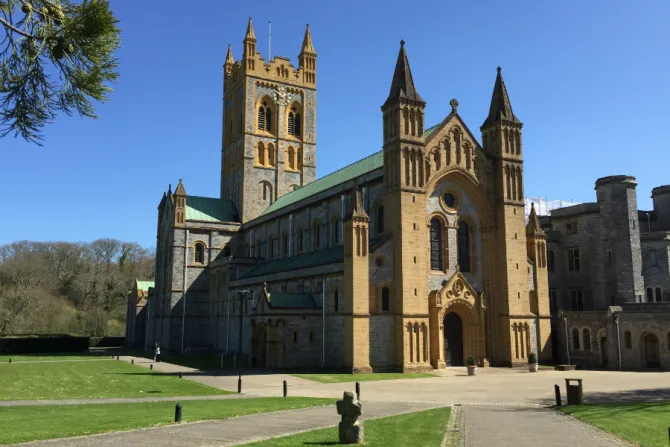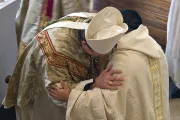The famous image of Our Lady of Buckfast that greets visitors as they approach the monastery was also redone. Crafted by a local artist with her neighbor and her neighbor's baby as models, the statue depicts a smiling Mary holding a smiling infant Christ in a relaxed pose on her hip.
Based on the medieval original, which was destroyed during the sacking of the monastery in the 1500s, the statue, according to Charlesworth, is meant to depict "the joy of motherhood."
"You don't typically see statues like that," with Mary's soft but full smile, and her relaxed pose, he said, explaining that when he initially commissioned the statue in 2012, "I specifically asked that be emphasized...the smiling motherly face of Mary and child."
When pilgrims arrive, he explained, they see Christ "smiling and looking at them as a child – because he was a child – and there is Mary looking at her Son in the joy of motherhood."
Various liturgical events are also set to take place, with three major Masses scheduled throughout the year. The first will take place on the May 24 feast of Our Lady of Buckfast, which will mark the diocesan celebration.
The bishops of England, Wales, and Scotland will all be invited to the Mass. Parish priests and representatives of parishes in the area will also be invited.
The next major liturgical event will be the singing of Vespers by the abbey choir on the July 11 feast of St. Benedict. Members of both civil society and the Church of England will be invited for a civic and ecumenical celebration of the anniversary.
Another Mass will be offered on the Aug. 25 feast of the Dedication of the Abbey, which will be more of a community celebration for the abbey parish staff and their families.
On Oct. 27 a Votive Mass will be offered for the Oct. 27 feast of Saints Simon and Jude, which will be celebrated by the Benedictine Abbot Primate, Gregory Polan of Conception Abbey in Missouri, who will come in from Rome for the celebration.
The Mass will primarily be for the monks and nuns of the Benedictine family, particularly those from France and in Germany, since the first monks to re-settle Buckfast in the 19th century were French and German.
With around 120 employees on staff and 3-400,000 visitors a year, Buckfast is far from a small presence in the area. However, there are only 15 monks, including Abbot Charlesworth, who live in the enclosed monastery of the abbey.
But according to Charlesworth, "the vitality of a monastic community witness does not depend so much on the age or number of members as on their manner of living the monastic life."
Going into the future, he hopes Buckfast Abbey is able to offer a concrete service based on "Christ-centered hospitality" to the mission of the Church as a whole, but specifically the pilgrims who come.
"The monastic life itself is our way of participating in the mission of Christ and his Church," the abbot said, adding that it offers both the Church and the world "a strong clear sign of the very nature of the Christian life."
Though the monks are enclosed, that doesn't mean they are inactive or that their presence isn't felt, he said, because if lived properly through a life of prayer and asceticism, monastic life "assumes an evangelical importance, being the attitude and behavior which demonstrates our faith at the point of contact with each other and the world."
"To witness the contentment and pleasure that others experience here is a great joy," he said, noting that for many of Buckfast's visitors, the monastery is a place "where they are uplifted and find peace," which in itself is "an important source of encouragement."
This opportunity for peace, joy and renewal is a primary way to evangelize, particularly amid a busy and often hectic rhythm, he said.
Evangelization, he said, "should seek to orientate our human freedom towards God, who is the source of truth, goodness and beauty."
Because of this, a life of prayer is also a mode of evangelization, he said, explaining that "the Spirit given to us in prayer and the sacraments encourages us to spread the Good News of Jesus in word and deed" to the community, and to visitors.
"For us, the three-fold mission of liturgy, hospitality and evangelization helps us to express our commitment, through our monastic calling to the life of the Gospel," Charlesworth said, stressing that "we do not have to work away from the monastery to bear witness to Jesus."
"Within the monastic enclosure, if we are willing to cooperate with each other and collaborate with those who share our vision, we have the resources to bring hope and joy to those in need."
Elise Harris was senior Rome correspondent for CNA from 2012 to 2018.




